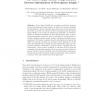44 search results - page 2 / 9 » When Abstractions Met Landmarks |
SSPR
1998
Springer
13 years 9 months ago
1998
Springer
Abstract. A representation of a three-dimensional object is autonomously learned from a sequence of the rotating object. The representation consists of single views in form of grap...
IROS
2006
IEEE
13 years 11 months ago
2006
IEEE
Abstract— This paper presents a new approach to the multirobot map-alignment problem that enables teams of robots to build joint maps without initial knowledge of their relative ...
MVA
2010
13 years 16 hour ago
2010
Abstract In this paper we compare the behavior of different interest points detectors and descriptors under the conditions needed to be used as landmarks in visionbased simultaneou...
ICRA
2005
IEEE
13 years 11 months ago
2005
IEEE
Abstract— Landmark-based graphs are a useful and parsimonious tool for representing large scale environments. Relating landmarks by means of feedback-control algorithms encoded i...
IPMI
2005
Springer
14 years 6 months ago
2005
Springer
Abstract. Active Shape Models are a popular method for segmenting three-dimensional medical images. To obtain the required landmark correspondences, various automatic approaches ha...

